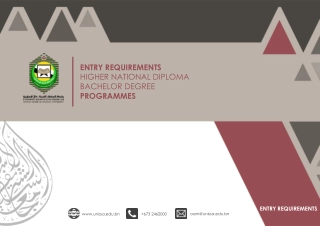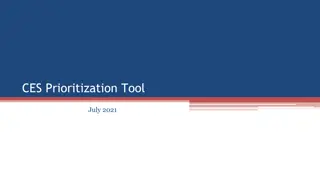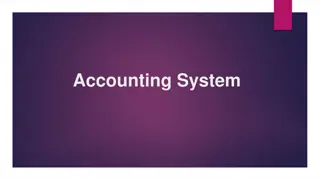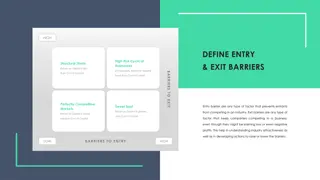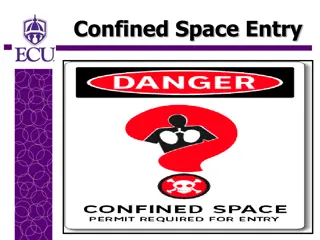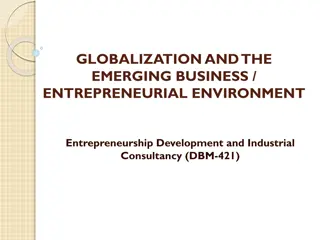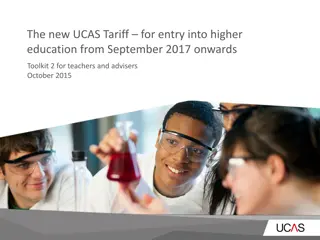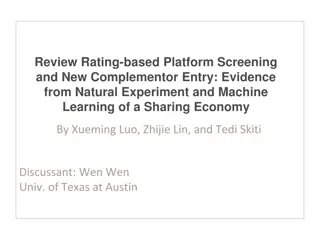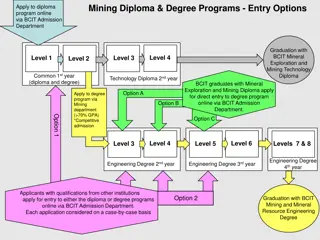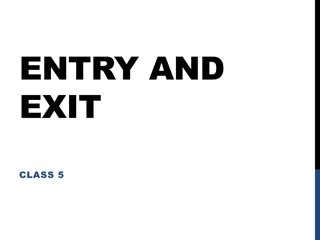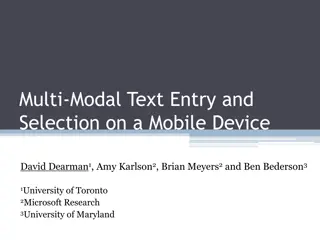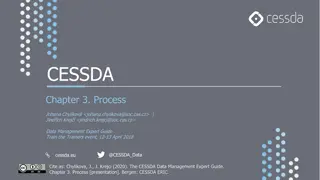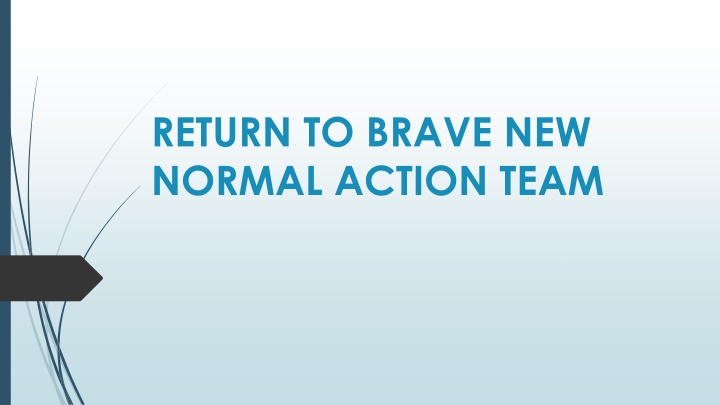
Creating a Brave New Normal Action Team for Campus Return Planning
"Join the dedicated team at Forsyth Tech to plan a successful transition from remote operations to a brave new normal in response to COVID-19. Dr. Spriggs leads the charge with guiding principles focused on excellence, innovation, and resilience for a sustainable future. Collaborate with experts in various fields to shape short-term and long-term strategies, emphasizing student success, equity, and community transformation."
Uploaded on | 0 Views
Download Presentation

Please find below an Image/Link to download the presentation.
The content on the website is provided AS IS for your information and personal use only. It may not be sold, licensed, or shared on other websites without obtaining consent from the author. If you encounter any issues during the download, it is possible that the publisher has removed the file from their server.
You are allowed to download the files provided on this website for personal or commercial use, subject to the condition that they are used lawfully. All files are the property of their respective owners.
The content on the website is provided AS IS for your information and personal use only. It may not be sold, licensed, or shared on other websites without obtaining consent from the author.
E N D
Presentation Transcript
RETURN TO BRAVE NEW NORMAL ACTION TEAM
TEAM MEMBERS Jeff Armstrong-Coordinator, Environmental Services-HR Admin. Services Scott Booth-Director, Facilities-HR Admin. Services Jennifer Gay- Account Technician-Business Services Kristie Hendrix- Executive Director-Off-site Centers Phillip Hopkins-Associate Professor, Collision Repair & Refinishing-Instructional Services Kevin McCann-Director, Client Services-Information Technology Services Tony McKinnon-Conduct Officer/Title IX Coordinator-Equity & Educational Support Services Carolyn McMackin- Chief-Campus Police Jeremicus Porter-Coordinator, Student Life Engagement, Student Success Services Jim Rosenberger-Human Resources Analyst, HR Admin. Services John Sherman-Interim Director, Health Services & Prog. Coord. RT-Instructional Services Anna Marie Smith- Vice President, Human Resources and Administrative Services, Human Resources/Administrative Services Stacy Waters-Bailey: Executive Director-Student Support Services
Dr. Spriggs charge to the team Short Term Return to Campus Planning: It is time to pivot, from COVID-19 remote operations response, to COVID-19 return to brave new normal response. This requires subject matter expertise from across the College, and each person in this group brings critical insight and experience to the team. The teams first and highest priority is to recommend plans for transitioning from all remote teaching, learning, and business operations, to the necessary combination of remote and on-campus teaching, learning, and business operations. Time is of the essence as the situation continues to evolve and multiple stay-at-home orders and recommendations from governmental and health professionals are in place to guide decisions. The team will make recommendations to the Executive Leadership Team (ELT) quickly to facilitate a smooth and clearly communicated transition. Long Term Brave New Normal Planning: The second priority for the team is to evaluate the implications resulting from the pandemic and make recommendations to ELT on how to manage our continuing environment and our brave new normal in the longer term. The expectation for the long term includes considerations for fall 2020 and spring 2021, and should consider the possibility of another COVID-19 disruption
Guiding Principles for Creating our Short- Term Plans and our Brave New Normal: As we move out of the remote learning and operations mode resulting from the COVID-19 pandemic, and back to our Brave New Normal, we must: Adapt in response to the new environment in which we now find ourselves while protecting our mission to advance student success through excellence in learning, completion, equity and post-graduation outcomes. Protect our College values: Excellence, Learning, Innovation, Diversity, and Integrity Lead bravely and boldly towards achieving our vision of being a catalyst for equitable economic mobility, empowering lives and transforming communities. Listen to our students, employees, governmental leaders, health and safety professionals, business and community leaders, nonprofit partners, and other external partners and stakeholders as we shape our short-term return to campus and as we build resilience for longer term strategies. Preserve fiscally sustainable operations and robust stewardship of Forsyth Tech staff and faculty. Communicate consistently, relevantly and clearly. Lead calmly, confidently, courageously and compassionately.
Timeline Week of April 13th: Pre-work planning April 24: Return to Brave New Normal Guiding Team Meeting April 28: First Rough Draft Complete April 30: Final Draft Complete May 4: Present Re-Entry Plan to ELT
Phase I Based on the recommendations of the Governor, Forsyth Tech s re-entry guidelines will expand current access to Main Campus, West Campus, TTC, and NWFC from essential employees to designated employees as determined by Division VP. Capacity reduced by 50% Self-monitoring Recommend face masks (to be provided) Staggered scheduling Social distancing No more than 10 in any office area/encouraged to remain in office Telework available on case-by-case basis and manager approval Housekeeping clean multiple times/day to include instructors cleaning their class/lab.
RE-ENTRY IN PHASES-PHASE 1 FT PHASE I Tentative May 11 GOVERNOR S PHASE I Tentative May 11 20% of staff in each division as determined by the VP of respective division: Stay at Home Order remains in place, people can leave home for commercial activity ELT, VPs, Associate VP, Deans, Executive Directors Those retailers and services will need to implement social distancing, cleaning and other protocols 20% of staff in each division as determined by the VP of respective division with the exception of the following areas which will be open normal business hours beginning May 11, with limited staff: Gatherings limited to no more than 10 people Parks can open subject to gathering limits Face coverings recommended in public Cashier s Office at Main, West Campus, and NWFC (online payment and telephone payment are encouraged) Restrictions remain in place for nursing homes and other congregate living settings ITS Support Desk Encourage continued teleworking Financial Aid Records Admissions Student Services (remote advising is encouraged)
Phase II Maintain current access from Phase I to include Main Campus, West Campus, NWFC, and TTC from essential employees to 40% of each area as designated employees as determined by Division VP. Innovation Quarter, Swisher, and Woodruff to open June 1. Stokes to open as needed for LPN program after June 1. Capacity reduced by 50% Self-monitoring Recommend face masks (to be provided) Staggered scheduling Social distancing No more than 10 in any office area/encouraged to remain in office Telework available on case-by-case basis and manager approval Housekeeping clean multiple times/day to include instructors cleaning their class/lab.
RE-ENTRY IN PHASES-PHASE II FT PHASE II GOVERNOR S PHASE II (2- 3 weeks after Phase I) (2-3 weeks after Phase I) Tentatively May 26 or June 1 Tentatively May 26 or June 1 40% of staff Lift Stay at Home Order with strong encouragement for vulnerable populations to continue staying at home Allow limited opening of restaurants, bars and other businesses that can follow strict safety protocols (reduced capacity) Allow gathering at houses of worship and entertainment venues at reduced capacity Increase in number of people allowed at gatherings Open public playgrounds Continue rigorous restrictions on nursing homes and congregate care settings Tentative-June 1st: Students allowed to return to campus for scheduled lab times to work on lab learning objectives/EWD regular scheduled classes. Class/lab capacity would be 50% of normal capacity. Individual divisions / programs will be responsible for staggering meeting days/times to ensure the minimum number of students in a common area at any one time. Another factor to be considered is the square footage of the given lab space.
Phase III Maintain current access from Phase I and II to include Main Campus, West Campus, NWFC, and TTC from essential employees to weekly percentages of each area as designated employees as determined by Division VP. Capacity reduced by 50% Self-monitoring Recommend face masks (to be provided) Staggered scheduling Social distancing No more than 10 in any office area/encouraged to remain in office Telework available on case-by-case basis and manager approval Housekeeping clean multiple times/day to include instructors cleaning their class/lab.
RE-ENTRY IN PHASES-PHASE III GOVERNOR S PHASE III (4-6 Weeks after Phase II) Tentatively June 22,June 29, or July 6 Lessen restrictions for vulnerable populations with encouragement to continue practicing social distancing Allow increased capacity at restaurants, bars, other businesses, houses of worship and entertainment venues Further increase the number of people allowed at gatherings Continue rigorous restrictions on nursing homes and congregate care FT PHASE III-Week 1 (4-6 Weeks after Phase II) Tentatively June 22,June 29, or July 6 Week 1: 60% of staff in each division as determined by the VP of respective division
RE-ENTRY IN PHASES-PHASE III GOVERNOR S PHASE III (4-6 Weeks after Phase II) Tentatively June 22,June 29, or July 6 Lessen restrictions for vulnerable populations with encouragement to continue practicing social distancing Allow increased capacity at restaurants, bars, other businesses, houses of worship and entertainment venues Further increase the number of people allowed at gatherings Continue rigorous restrictions on nursing homes and congregate care FT PHASE III-Week 2 (4-6 Weeks after Phase II) Tentatively June 22,June 29, or July 6 Week 2: 80% % of staff in each division as determined by the VP of respective division
RE-ENTRY IN PHASES-PHASE III GOVERNOR S PHASE III (4-6 Weeks after Phase II) Tentatively June 22,June 29, or July 6 Lessen restrictions for vulnerable populations with encouragement to continue practicing social distancing Allow increased capacity at restaurants, bars, other businesses, houses of worship and entertainment venues Further increase the number of people allowed at gatherings Continue rigorous restrictions on nursing homes and congregate care FT PHASE III-Week 3 (4-6 Weeks after Phase II) Tentatively June 22,June 29, or July 6 Week 3: 100 % of staff in each division as determined by the VP of respective division
RE-ENTRY IN PHASES-STUDENT COMPONENT June 1 or July 6 Class/Labs reduced capacity by 50% Social distancing of employees and students Housekeeping by cleaning surfaces multiple times a day
Determining Return to Work Employees whose work cannot be done remotely should be prioritized when determining who should return to work. When bringing back employees in phases, Supervisors should not use legally protected categories (age, disability, etc.) when identifying those employees who should not return to work. Supervisors should make return to work decisions by job function, department or geography, or other job-related factors. When the employee is selected to return to work by the Supervisor, the decision to return to work is ultimately left up to the employee, not the Supervisor.
Determining Return to Work Because employees will be selected to return to work in phases, there will be some full-time employees who cannot work remotely. In addition, there will be some employees who do not return to work due to personal illness, a family member s illness, lack of childcare or they do not feel comfortable returning to the work environment. Full-time employees who are unable to work remotely and are not scheduled to return during the re-entry period, or who cannot/will not return to work during the re-entry period due to COVID-19 related concerns or challenges may: Use available bonus, annual or sick leave; or Request paid leave under the Families First Coronavirus Response Act (FFCRA), if eligible. or Request leave under the Family Medical Leave Act (FMLA), if they are eligible.
Scenarios: Scenario #1: A student, Janie, walks in to Admissions. She goes in the door marked Enter. She stands where indicated by the floor markings. She discusses her needs from that indicated area. The admissions counselor is wearing a face mask when talking with the student. She leaves out the door marked Exit. Scenario #2: Janie has registered for classes and now wants to pay in person. She comes to Allman and when sees the sign indicating that only two people are allowed on the elevator she decides to take the steps up to the cashier s window. She stands at the appropriate place as indicated by the social markings. When it is her turn to pay, she talks with the cashier who is wearing a face mask. After Janie pays, she uses hand sanitizer that is on the counter. Scenario #3: A full-time employee, Fin, is apprehensive about coming back to work. His supervisor has had manager s training provided by Human Resources. When talking with Fin, the manager discusses the needs of the college and the need for Fin to return to work. Fin is still fearful about returning to work. The supervisor lets Fin know if he does not feel safe returning to work, he can take available bonus, sick or annual leave to cover the time he is absent. If Fin has a qualifying condition that makes him eligible for leave under the FMLA or FFCRA, Sam may apply for leave through Human Resources.
Proposed Communication Upon Approval of Plan The Re-entry Team will develop information for a Return to Work email. The suggestion is that once that information is approved, Dr. Spriggs sends out a communication to employees and students on Thursday in a President s Message. The message to employees will have a Q and A section. The communication to students will be separate and focus on the return of services and classes/labs.
Key Decisions to be Made Will students return on June 1 or July 6? What centers to open and when Is the percentage returning to work too fast? Too slow? Acceptable?

